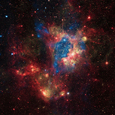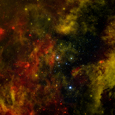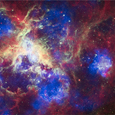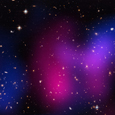Disclaimer: This material is being kept online for historical purposes. Though accurate at the time of publication, it is no longer being updated. The page may contain broken links or outdated information, and parts may not function in current web browsers. Visit chandra.si.edu for current information.
Chandra in 2012: A Teenager in Space
by Wallace TuckerDec 14, 2012 ::
In July of 2012, Chandra completed its 13th year of operation, making it a teenager. That is young in human terms, but it is getting up there for an automobile, and could be considered a "senior citizen" for a spacecraft of Chandra's complexity. How many computers do you have that are 13 years old? Chandra's magnificent sister NASA flagship observatory, Hubble, is older, at 22, but astronauts have paid 4 house calls to make major upgrades over the years.
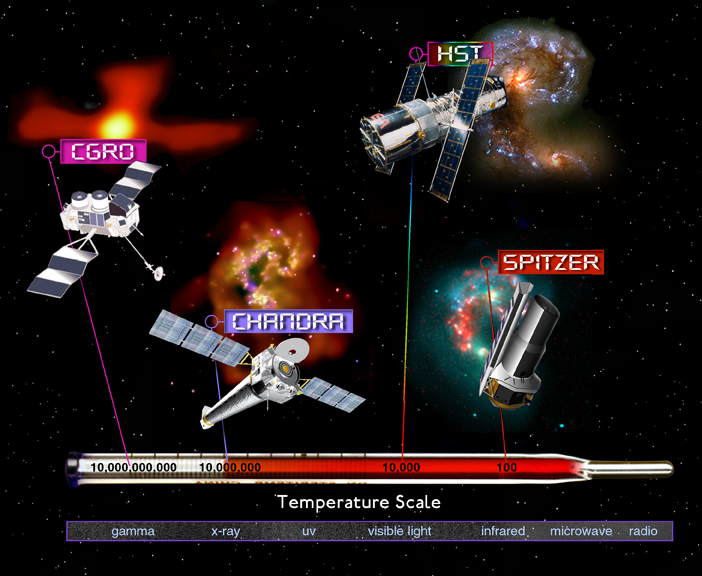
Chandra never gets closer than about 6,000 miles to Earth, so once it was pushed out of the Columbia space shuttle, Chandra was on its own, and has had to rely on "life-style" adjustments if anything goes wrong. A recent high-level checkup showed that very little has gone wrong, and the health of the spacecraft is excellent. A few "aches and pains" associated with age, such as degradation of the spacecraft's insulation, have made scheduling more complicated so as to avoid too much sunlight, but this should have no significant impact of the scientific productivity of Chandra for at least another decade.
The picture that emerged from the 2012 NASA senior review of Chandra is that of a major observatory in its prime. "Chandra," the reviewers concluded, "has the sensitivity, angular resolution, and spectral capability to make major contributions to practically every field of astronomy and astrophysics." The reviewers went on to say that "There is no instrument planned for at least the next two decades that will have an angular resolution (in X-rays) approaching that of Chandra."
The images included here are drawn from dozens of images posted on our website (from among hundreds taken) in the past year to show the breadth and depth of research done using Chandra. Luminous, turbulent, young stars, old stars at the end of their evolution, the rapidly expanding remains of exploded stars, a supermassive black hole hidden in the center of a galaxy, and three objects from one of the favorite types of targets for Chandra - clusters of galaxies.
These images also illustrate the importance of using different types of telescopes (radio, infrared, optical, and X-ray) to provide a more complete and accurate picture of what's going on.
The NGC 1929, Cyg OB2, and 30 Doradus images are composite, multi-wavelength images of star-forming regions containing thousands of stars. The huge clouds of dust and gas from which these stars form are very cold (hundreds of degrees below zero Celsius), and dark at visible wavelengths, but they are bright to an infrared telescope. Chandra is critical for sorting out the hot, young, stars from numerous foreground stars and obscuring dust and gas, and for tracing the cumulative effects of stellar winds and supernova shock waves on the star-forming clouds: giant bubbles are carved out, and the walls of these bubbles are eroded by the scouring effects of the hot winds and shock waves.
The synergy of observations with different telescopes is also apparent in the images of clusters of galaxies: the El Gordo, Abell 520, Abell 383, and the Musket Ball clusters. Clusters, the most massive gravitationally bound objects in the universe, contain a mass in stars equal to about ten trillion Suns, enough hot gas to make about hundred trillion Suns, and a mass in dark matter equal to almost a quadrillion Suns!
Although the nature of the dark matter is still a mystery, combined X-ray and optical observations have offered the most direct proof yet that dark matter exists. Giant clusters are built up through violent collisions and mergers of smaller clusters over a period of billions of years. During these collisions, the frictionless clumps of dark matter, and the stars in the galaxies will pass through one another, but the friction between the two hot gas clouds will pull them away from their dark matter. The separation of normal and dark matter can be detected by combined observations with Chandra, which images the X-rays from the normal matter, and optical data, which reveals the presence of dark matter through subtle distortions of the shapes of galaxies produced by dark matter. This effect was first demonstrated in the Bullet Cluster, a system so named because a very high speed collision produced a bullet-shaped distortion in the hot gas of one of the colliding clusters.
Further observations have shown that the Bullet Cluster is not unique. The DLSCL J0916.2+2951 image shows one such system, which is nicknamed the Musket Ball cluster, because it is an older and slower version of the Bullet cluster. This merger, which exhibits the largest separation of dark and normal matter yet detected, is thought to be about 700 million years along, so it will be extremely useful for further study of delayed effects of mergers, such as triggering the formation of stars over a vast region. Finally, there is Abell 520, a messy merger that seems to break all the rules, with dark matter and normal matter intermingled in a way that no one understands.
Stay tuned to http://chandra.si.edu for further Chandra developments in the years to come.
Disclaimer: This material is being kept online for historical purposes. Though accurate at the time of publication, it is no longer being updated. The page may contain broken links or outdated information, and parts may not function in current web browsers. Visit chandra.si.edu for current information.

